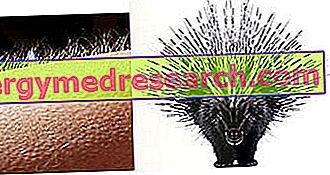

The cabbage and the cabbage are two subspecies of the well-known Brassica oleracea L., a plant belonging to the Brassicaceae family; in botany, the cabbage is known as " capitata ", while the cabbage is called " sabauda ".
The cabbage has smooth and falling leaves, easily reaches 50cm in height and the edible part is made up of the central shoot which, as outside, can be green or red (depending on the quality); both types of cabbage (green or red) boast the same botanical, chemical-nutritional (except pigment content) and cultivation characteristics. Savoy cabbage is very similar to the previous one but has wrinkled leaves with numerous wrinkles and protrusions.
The cabbage and the cabbage can be classified according to the time of collection; there are early, summer and late ones, although, from the dietary point of view, like most Brassica oleracea L. (especially Brussels sprouts ), they are a typically winter vegetable. Their resistance to cold represents a strongly "desirable" characteristic since, in the presence of low temperatures, most vegetables and fruits (vitamin C contributors) "should" be scarce or even disappear (except for potatoes which, from on their part, they need prolonged cooking with the abatement of vitamin C contained in them).
The most famous varieties of cabbage and cabbage are:
- Early white cabbage: Copenhagen Market (tapered), Gloria of Enkhuizen, Filderkraut Spezialzucht (recommended for the production of Sauerkraut)
- Early red cabbage: Negro head
- Savoy cabbage: D'Asti Pasqualino
- Late red cabbage: Septemberrot, Monhrenkopl
- Late cabbage: Late of the Virtues, Of Piacenza.
How to Cook Fat-Free Cabbage
X Problems with video playback? Reload from YouTube Go to Video Page Go to Video Recipes Section Watch the video on youtubeCultivation
The cabbage and the savoy cabbage, like the other Brassica oleracea L., are plants that (due to the relative leaf mass) greatly exploit the soil, therefore, they both need to be placed in first place in the "crop rotation". The round cabbage and the cabbage require a large space between the plants, therefore in the cultivation of small vegetable gardens varieties of cabbage with a "slender" shape (such as Mercato di Copenhagen) are more suitable.
The cabbage and the cabbage need a well-fertilized soil since autumn with the use of mature manure, manure or meat-blood-bone meal; a very effective supplementary fertilizer could be based on rock flour and nettle macerated. NB : Excess fertilization is as harmful as the use of impoverished soil.
The sowing of the cabbage and the cabbage takes place, according to the earliness or late, between March and April in sowing beds, after which (from April to June, again depending on the variety) they can be transplanted in the field at a distance of 40x40 or 50x50cm; for the success of the cultivation of cabbage and cabbage it is necessary to keep the soil soft and possibly moist.
The collection of cabbage and cabbage changes according to the variety of the plant; late ones resist up to the first frosts while white cabbage can be fermented and stored in pots in the form of Sauerkraut. They are suitable for intercropping with cabbage and cabbage: tomatoes, celery, potatoes, spinach, salads, leeks and peas.
Nutritional characteristics
The cabbage and the cabbage are vegetables that belong to both the VI and the VII group of foods since, even in the absence of ALL the reference values, it is conceivable that they contain high amounts of vitamin C ( ascorbic acid ) and B-carotene ( retinol eq. - pro-vitamin A ); regarding this vitamin concentration and that of many other antioxidants (especially phenolic substances), cabbage and cabbage are considered protective foods against various cancers. Furthermore, the high content of dietary fiber is very effective in promoting correct intestinal functioning (preventive and curative towards constipation).
The intake of potassium and iron (although the latter is not very bioavailable) of green, raw cabbage is appreciable; it is not clear whether the purine content of cabbage and cabbage is similar to that of cauliflower (and probably broccoli) or lower.
By virtue of their resistance to cold, as with Brussels sprouts, late cabbage and cabbage served a DETERMINANT dietary function for all northern populations or colonizing continental territories. Late cabbage and savoy cabbage, like citrus fruits for the ethnic groups of the Mediterranean basin, are an excellent source of vitamin C and retinol equivalents for most of the rigid season (during which it would NOT be possible to find other vegetables instead available in the temperate season). Finally, green cabbage is the basis for the preparation of sauerkraut, a fermented food to be cooked cooked (therefore depleted of easily oxidizable and thermolabile vit. C) rich in many other vitamins derived from microbial lactic fermentation.
Spelled and Savoy Soup
X Problems with video playback? Reload from YouTube Go to Video Page Go to Video Recipes Section Watch the video on youtubeNutritional values (per 100 g of edible portion)
| Nutritional composition per 100 grams of edible part. Green cabbage, raw : | ||||||||||||||||||||||||||||||||||||||||||||||||||||||||||||||||||||||||||||||||||
 | ||||||||||||||||||||||||||||||||||||||||||||||||||||||||||||||||||||||||||||||||||
| ||||||||||||||||||||||||||||||||||||||||||||||||||||||||||||||||||||||||||||||||||
| Nutritional composition per 100 grams of edible part Red cabbage : | ||||||||||||||||||||||||||||||||||||||||||||||||||||||||||||||||||||||||||||||||||
 | ||||||||||||||||||||||||||||||||||||||||||||||||||||||||||||||||||||||||||||||||||
| ||||||||||||||||||||||||||||||||||||||||||||||||||||||||||||||||||||||||||||||||||
| Nutritional composition per 100 grams of edible part Cabbage green, boiled : | ||||||||||||||||||||||||||||||||||||||||||||||||||||||||||||||||||||||||||||||||||
 | ||||||||||||||||||||||||||||||||||||||||||||||||||||||||||||||||||||||||||||||||||
| ||||||||||||||||||||||||||||||||||||||||||||||||||||||||||||||||||||||||||||||||||
| Nutritional composition per 100 grams of edible part Savoy cabbage, raw : | ||||||||||||||||||||||||||||||||||||||||||||||||||||||||||||||||||||||||||||||||||
 | ||||||||||||||||||||||||||||||||||||||||||||||||||||||||||||||||||||||||||||||||||
| ||||||||||||||||||||||||||||||||||||||||||||||||||||||||||||||||||||||||||||||||||
Bibliography:
- Vegetable garden and organic garden - ML Kreuter - Giunti - pag 164.



